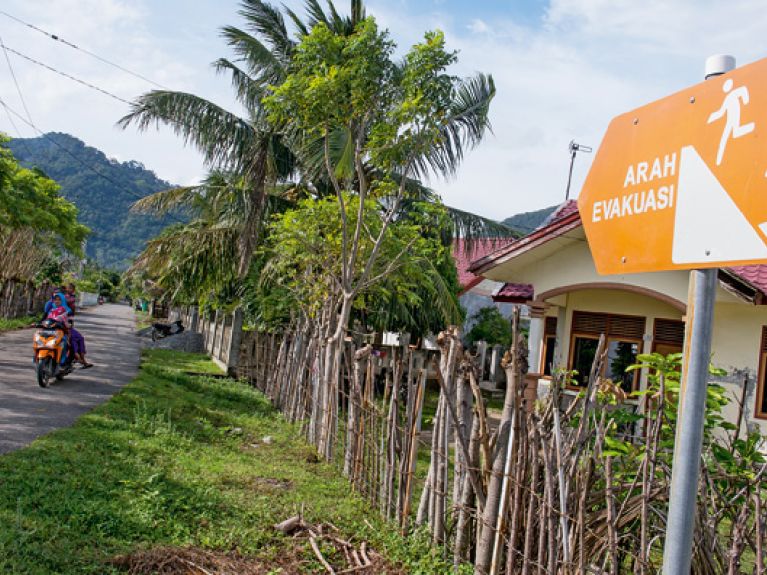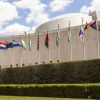A knowledge advantage that saves lives
The Indonesian Tsunami Early Warning System exemplifies the concept that defines modern disaster reduction: “preparedness”.

It’s 2 March 2016, 7:49 pm local time, when the Earth shakes violently off the coast of Sumatra: 7.7 on the Richter scale. Control centre staff at the Tsunami Early Warning System in Jakarta stare attentively at their monitors. Will a giant wave strike? Using computer simulations, they analyse the data from hundreds of seismometers and measuring devices in the Indian Ocean. Less than five minutes after the earthquake, the duty engineer takes the decision to issue a yellow alert. Radio and television stations announce the danger, text messages are sent, and sirens mounted on the roofs of mosques begin to wail in coastal villages. This evening, fortunately, a wave does not appear, and soon the all-clear sounds.
Over 10,000 kilometres away, at the German Research Centre for Geosciences (GFZ) in Potsdam, Jörn Lauterjung follows these events as they happen. The physicist has a strong attachment to the Tsunami Early Warning System; it’s like a child he has supported from birth. He is satisfied, he says, that the “warning chain” worked, even if there was no disaster this time. “I see this the Japanese way: we didn’t have a false alarm, we had good luck. When the devastating tsunami struck in December 2004, people had neither warning nor luck: roughly 230,000 died, although many of them would have had enough time to reach safety.
The early warning system aims to save lives by providing an all-important knowledge advantage. Lauterjung and his colleagues developed the system on behalf of the Federal Government in collaboration with Indonesian partners. Germany provided some 55 million euros for the project from 2005 onwards. The system was handed over to Indonesia in 2011 – for Lauterjung, the project’s scientific father, it was a wonderful moment, because it demonstrated “how much people there identify with the project”. The GFZ researchers continue to play a role as consultants and also organise training programmes for the 60 warning centre employees, who monitor earthquake activity around the clock in three shifts. Since 2007 they have issued 20 warnings, which in 70 to 80% of cases have actually been followed by tidal waves.
Nevertheless, high-tech and experts alone do not offer all-round protection. Only when combined with intelligent emergency plans and a well-informed population can you come closer to reaching the level of preparedness that is the goal of modern disaster reduction: the consequences of an emergency should be alleviated in advance and human suffering and material damage avoided. The Tsunami Early Warning System also encompasses public education: so-called disaster management organisations have been set up to spread knowledge of the different warnings and escape routes in villages.
Whether in Indonesia or elsewhere, whenever Germany is involved in humanitarian assistance, its action is guided by the precautionary principle. Since 2011, the Federal Government has been actively promoting prevention as part of its Preparedness Initiative. A package of measures funded by Germany and coordinated by the German Red Cross (DRK) is also contributing to prevention in this field. In the pilot countries, including Bangladesh, Mozambique and Peru, meteorological and other data is being used to define thresholds for initiating standardised precautionary measures – before a potential disaster strikes. Based on forecasts, these preventive measures deliver a decisive time advantage in preparing for a disaster.
In the European Union and at the United Nations, too, Germany is working to strengthen the concept of prevention. Accordingly, it works closely with the office of the United Nations International Strategy for Disaster Reduction (UNISDR) and the Office for the Coordination of Humanitarian Affairs (OCHA). At the European level, Germany was deeply involved in the consensus on humanitarian aid and the EU strategy to promote disaster reduction in developing countries.
In 2015, Germany was represented by an interministerial delegation at the United Nations World Conference on Disaster Risk Reduction in Sendai, Japan. The outcome of the meeting was a framework agreement on disaster reduction that emphasised a precautionary approach to risks more strongly than ever before. Professor Jakob Rhyner also attended the gathering in Japan. He is Director of the Institute for Environment and Human Security at the United Nations University (UNU) and also Vice-Rector of UNU in Europe. The Swiss academic’s research includes work on avalanche accidents. In Central Europe, says Rhyner, it took centuries for the concept of prevention to gain precedence. Cultural factors played a not insignificant part in this: disasters were considered God-given, which is how they are still seen in many places today.
Another obstacle is the expense – despite the fact that investment in prevention pays off. The economic costs of natural disasters worldwide add up to roughly 270 billion euros a year. According to Rhyner, this figure could be significantly reduced by risk analysis and prevention. Every euro spent on precautionary measures saves several euros on dealing with the consequences of disasters. “Good preparation is profitable.” That applies even more if you take into account the indirect costs. After all, earthquakes, tsunamis and cyclones often set back the development of entire countries – as happened in Haiti.
Mahamadou Issoufou-Wasmeier heads up the national office of Deutsche Welthungerhilfe in Port-au-Prince. When he walks through the streets of the capital today, many things still remind him of the day in January six years ago when a severe earthquake shook the small island republic. Over 220,000 people died; millions became homeless. The disaster was a wake-up call. “Since then people here give a great deal more thought to risks.”
In addition to earthquakes, in Haiti these include floods and periods of drought. Suffering as it does from the effects of El Niño, the country does not only face major disasters, but also smaller, more insidious ones. That is why, explains Issoufou-Wasmeier, Welthungerhilfe considers prevention in all its projects. “For us it’s a crosscutting theme. Whether the question is food security or irrigation systems, prevention always plays a role.”
Welthungerhilfe in Haiti has also set up an extensive system of information delivery to ensure individuals act appropriately in the event of an emergency. Working through committees in villages, among other things, it offers courses that simulate disasters and inform participants of the best way to respond. The non-governmental organisation has already reached some 25,000 people directly in this way.
Intense poverty makes the situation more difficult. “Knowing about the right form of protection is one thing; the means of realising it another,” says Issoufou-Wasmeier. Researcher Jakob Rhyner also refers to the “underlying factors” emphasised by the Sendai Framework: poverty, corruption and conflicts increase the danger of a country being seriously affected by a disaster. “The risks can only be really effectively reduced if poverty is alleviated too.” ▪

